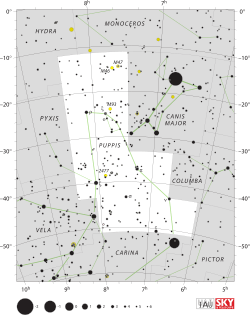Tau Puppis
Tau Puppis (Tau Pup, τ Puppis, τ Pup) is a star in the southern constellation of Puppis. It has an apparent visual magnitude of +2.95[2] and is located at a distance of about 182 light-years (56 parsecs) from Earth.[1] This is a spectroscopic binary star system, with the presence of the secondary component being revealed by the shifts of absorption lines in the spectrum resulting from the Doppler effect. The two components orbit each other with a period of 1,066.0 days (2.9 years) and a low eccentricity of 0.090.[6]
 | |
| Observation data Epoch J2000 Equinox J2000 | |
|---|---|
| Constellation | Puppis |
| Right ascension | 06h 49m 56.16846s[1] |
| Declination | –50° 36′ 52.4437″[1] |
| Apparent magnitude (V) | +2.95[2] |
| Characteristics | |
| Spectral type | K1 III[3] |
| U−B color index | +1.195[2] |
| B−V color index | +1.20[2] |
| Astrometry | |
| Radial velocity (Rv) | +36.4[4] km/s |
| Proper motion (μ) | RA: +34.36[1] mas/yr Dec.: –69.11[1] mas/yr |
| Parallax (π) | 17.92 ± 0.40[1] mas |
| Distance | 182 ± 4 ly (56 ± 1 pc) |
| Absolute magnitude (MV) | −0.80[5] |
| Orbit[6] | |
| Period (P) | 1,066.0 days |
| Semi-major axis (a) | 7.15 ± 0.25 mas |
| Eccentricity (e) | 0.090 |
| Inclination (i) | 80.20 ± 6.10° |
| Longitude of the node (Ω) | 2.90 ± 6.20° |
| Periastron epoch (T) | 2420992.8 HJD |
| Argument of periastron (ω) (secondary) | 64.00° |
| Details | |
| Radius | 27[7] R☉ |
| Temperature | 4,500[8] K |
| Rotational velocity (v sin i) | 2.2[9] km/s |
| Other designations | |
| Database references | |
| SIMBAD | data |
The primary component of this system has a stellar classification of K1 III.[3] A luminosity class 'III' indicates this has expanded into a giant star after exhausting the supply of hydrogen at its core and evolving away from the main sequence of stars like the Sun. The interferometry-measured angular diameter of this star, after correcting for limb darkening, is 4.49 ± 0.07 mas,[11] which, at its estimated distance, equates to a physical radius of about 27 times the radius of the Sun.[7] It appears to be rotating slowly, with a projected rotational velocity of 2.2 km s−1.[9] This gives a lower bound on the azimuthal velocity of rotation along the star's equator. Tau Puppis is radiating energy from its outer envelope at an effective temperature of around 4,500,[8] giving it the orange hue of a cool, K-type star.[12]
References
- van Leeuwen, F. (November 2007), "Validation of the new Hipparcos reduction", Astronomy and Astrophysics, 474 (2): 653–664, arXiv:0708.1752, Bibcode:2007A&A...474..653V, doi:10.1051/0004-6361:20078357
- Cousins, A. W. J. (1972), "UBV Photometry of Some Very Bright Stars", Monthly Notes of the Astronomical Society of Southern Africa, 31: 69, Bibcode:1972MNSSA..31...69C
- Houk, Nancy (1978), Michigan catalogue of two-dimensional spectral types for the HD stars, 2, Ann Arbor: Dept. of Astronomy, University of Michigan, Bibcode:1978mcts.book.....H
- Wilson, Ralph Elmer (1953). "General catalogue of stellar radial velocities". Carnegie Institution of Washington. Bibcode:1953GCRV..C......0W. Cite journal requires
|journal=(help) - Cardini, D. (January 2005), "Mg II chromospheric radiative loss rates in cool active and quiet stars", Astronomy and Astrophysics, 430: 303–311, arXiv:astro-ph/0409683, Bibcode:2005A&A...430..303C, doi:10.1051/0004-6361:20041440.
- Jancart, S.; et al. (October 2005), "Astrometric orbits of SB^9 stars", Astronomy and Astrophysics, 442 (1): 365–380, arXiv:astro-ph/0507695, Bibcode:2005A&A...442..365J, doi:10.1051/0004-6361:20053003
- Lang, Kenneth R. (2006), Astrophysical formulae, Astronomy and astrophysics library, 1 (3rd ed.), Birkhäuser, ISBN 3-540-29692-1. The radius (R*) is given by:
- Pérez Martínez, M. Isabel; Schröder, K.-P.; Cuntz, M. (June 2011), "The basal chromospheric Mg II h+k flux of evolved stars: probing the energy dissipation of giant chromospheres", Monthly Notices of the Royal Astronomical Society, 414 (1): 418–427, arXiv:1102.4832, Bibcode:2011MNRAS.414..418P, doi:10.1111/j.1365-2966.2011.18421.x
- Costa, J. M.; et al. (February 2002), "The tidal effects on the lithium abundance of binary systems with giant component", Astronomy and Astrophysics, 382: 1016–1020, arXiv:astro-ph/0111539, Bibcode:2002A&A...382.1016C, doi:10.1051/0004-6361:20011676
- "* tau Pup". SIMBAD. Centre de données astronomiques de Strasbourg. Retrieved 2012-01-25.
- Richichi, A.; Percheron, I.; Khristoforova, M. (February 2005), "CHARM2: An updated Catalog of High Angular Resolution Measurements", Astronomy and Astrophysics, 431: 773–777, Bibcode:2005A&A...431..773R, doi:10.1051/0004-6361:20042039
- "The Colour of Stars", Australia Telescope, Outreach and Education, Commonwealth Scientific and Industrial Research Organisation, December 21, 2004, retrieved 2012-01-16